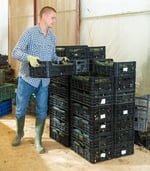
Food tracking in the supply has long been needed within our industry, especially across certain types of food. Over the last decade and beyond we’ve witnessed a tremendous effort by supply chain leaders to steer and push this concept forward. While we’ve made great strides, the overarching answer lies within a mixture of solutions.
When implementing a traceability solution  within a fresh food business, the issues can be broken down in several ways. Any solutions (and the problems being solved) will often fall into three categories. I call these categories the Three P’s: People, Process and Programming. When implementing any change, exploring each of these will open up the discussion to consider all aspects of the issues and help to enact positive change within an organization.
within a fresh food business, the issues can be broken down in several ways. Any solutions (and the problems being solved) will often fall into three categories. I call these categories the Three P’s: People, Process and Programming. When implementing any change, exploring each of these will open up the discussion to consider all aspects of the issues and help to enact positive change within an organization.
But for your company, what does your organization need to do?
Depending on who I talk to, the answer goes in a variety of directions. Technology advocates and those leaders that embrace software and hardware tend to point me at the IT department. “Talk to those guys,” is what they say. “They are the smart folks; they can figure it out and perform magic.”
When I hear this, I get worried.
While technology partially solves traceability  solutions and requires input from the IT department, the real solution is usually more nuanced. Throwing a new software service provider, a new software application or a new piece of hardware at the problem is only part of the solution. I’d encourage anyone that thinks they will solve this problem with technology alone to look a little deeper.
solutions and requires input from the IT department, the real solution is usually more nuanced. Throwing a new software service provider, a new software application or a new piece of hardware at the problem is only part of the solution. I’d encourage anyone that thinks they will solve this problem with technology alone to look a little deeper.
Then there are the process issues.
For a company to make a full traceability solution work, leadership must be willing to consider operational changes to internal processes. Implementing new protocols to meet new objectives within an organization requires amending existing workflows. The remedy starts with comprehensively documenting the processes on a workflow map, noting all the critical routes for data and the associated tasks that go along with it. This includes the exceptions. Do not make the mistake of only documenting perfect scenarios, otherwise critical missteps can occur.
When thinking through these processes, problem areas will naturally bubble to the surface. When this happens, everyone in the organization will see it on paper. Cross-functional and dependent tasks can be discussed and refined. I have seen it many times when one side of the business knew little of the impact it had on another side of the business. Process mapping is truly a beneficial exercise.
And last but not least are the people. Having  the right people in “the right seat on the bus” is essential for success with traceability or any complicated project. It’s important to align people with their jobs and tasks to where they connect to the outcome of their efforts. This can be accomplished by giving people the proper visibility into the result of their actions.
the right people in “the right seat on the bus” is essential for success with traceability or any complicated project. It’s important to align people with their jobs and tasks to where they connect to the outcome of their efforts. This can be accomplished by giving people the proper visibility into the result of their actions.
Traceability doesn’t have to be hard, but it does require attention to detail and to a thorough plan that addresses the “Three P’s.” It also helps to have a good partner, which is what we strive for here at Procurant. Given the stakes involved with food safety and business risk related to traceability and compliance with section 204 of the FSMA law, today’s retail grocers and produce suppliers should take advantage of every opportunity for success.
Procurant USA LLC
475 Alberto Way - Suite 230
Los Gatos, CA 95032
1-669-221-1026
info@procurant.com
